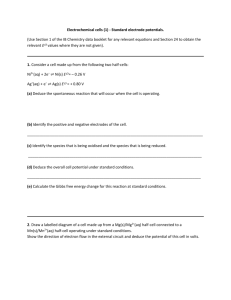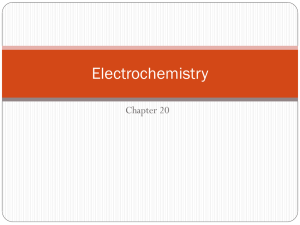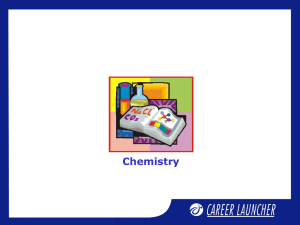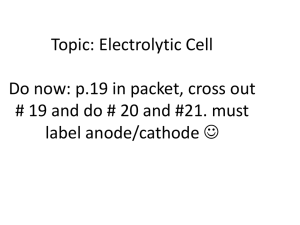Electrochemistry
advertisement
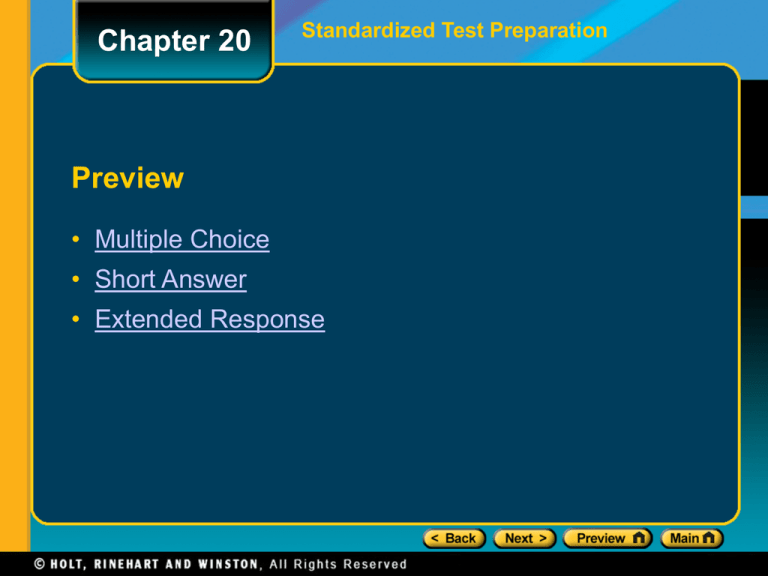
Chapter 20 Standardized Test Preparation Preview • Multiple Choice • Short Answer • Extended Response Chapter 20 Standardized Test Preparation Multiple Choice 1. The electrode at which reduction occurs is A. always the anode. B. always the cathode. C. either the anode or the cathode. D. always the half-cell. Chapter 20 Standardized Test Preparation Multiple Choice 1. The electrode at which reduction occurs is A. always the anode. B. always the cathode. C. either the anode or the cathode. D. always the half-cell. Chapter 20 Standardized Test Preparation Multiple Choice 2. Refer to the table of standard reduction potentials below. A voltaic cell contains a strip of zinc metal in a solution containing zinc ions in one half-cell. The second is a strip of tin metal in a solution containing tin ions. When this cell operates, A. Sn is oxidized and Zn2+ is reduced. B. Sn is reduced and Zn2+ is oxidized. C. Sn2+ is oxidized and Zn is reduced. D. Sn2+ is reduced and Zn is oxidized. Chapter 20 Standardized Test Preparation Multiple Choice 2. Refer to the table of standard reduction potentials below. A voltaic cell contains a strip of zinc metal in a solution containing zinc ions in one half-cell. The second is a strip of tin metal in a solution containing tin ions. When this cell operates, A. Sn is oxidized and Zn2+ is reduced. B. Sn is reduced and Zn2+ is oxidized. C. Sn2+ is oxidized and Zn is reduced. D. Sn2+ is reduced and Zn is oxidized. Chapter 20 Standardized Test Preparation Multiple Choice 3. When a rechargeable cell is being recharged, the cell acts as a(n) A. fuel cell. B. electrolytic cell. C. voltaic cell. D. Leclanche cell. Chapter 20 Standardized Test Preparation Multiple Choice 3. When a rechargeable cell is being recharged, the cell acts as a(n) A. fuel cell. B. electrolytic cell. C. voltaic cell. D. Leclanche cell. Chapter 20 Standardized Test Preparation Multiple Choice 4. Refer to the table of standard reduction potentials below. The standard potential of the cell Sn|Sn2+||Cr3+|Cr is −0.60 V. What is the standard reduction potential of the Cr3+/Cr electrode? A. +0.88 V C. −0.88 V B. +0.74 V D. −0.74 V Half-cell reaction Au3 3e– Cu2 2e– Fe2 2e– Sn2 2e– Zn2 2e– Mg2 2e– Au Cu Fe Sn Zn Mg Standard Reduction potential, E0 (in volts) +1.50 +0.34 -0.41 -0.14 -0.76 -2.37 Chapter 20 Standardized Test Preparation Multiple Choice 4. Refer to the table of standard reduction potentials below. The standard potential of the cell Sn|Sn2+||Cr3+|Cr is −0.60 V. What is the standard reduction potential of the Cr3+/Cr electrode? A. +0.88 V C. −0.88 V B. +0.74 V D. −0.74 V Half-cell reaction Au3 3e– Cu2 2e– Fe2 2e– Sn2 2e– Zn2 2e– Mg2 2e– Au Cu Fe Sn Zn Mg Standard Reduction potential, E0 (in volts) +1.50 +0.34 -0.41 -0.14 -0.76 -2.37 Chapter 20 Standardized Test Preparation Multiple Choice 5. Refer to the table of reduction potentials below. Which metal, Zn or Au, can reduce Sn2+ ions to Sn metal when placed in an aqueous solution of Sn2+ ions? A. Zn B. Au C. Both Zn and Au can reduce Sn2+ ions D. Neither Zn or Au can reduce Sn2+ ions Chapter 20 Standardized Test Preparation Multiple Choice 5. Refer to the table of reduction potentials below. Which metal, Zn or Au, can reduce Sn2+ ions to Sn metal when placed in an aqueous solution of Sn2+ ions? A. Zn B. Au C. Both Zn and Au can reduce Sn2+ ions D. Neither Zn or Au can reduce Sn2+ ions Chapter 20 Standardized Test Preparation Multiple Choice 6. When silver is electroplated onto another metal, Ag+ is A. oxidized at the anode. B. reduced at the anode. C. oxidized at the cathode. D. reduced at the cathode. Chapter 20 Standardized Test Preparation Multiple Choice 6. When silver is electroplated onto another metal, Ag+ is A. oxidized at the anode. B. reduced at the anode. C. oxidized at the cathode. D. reduced at the cathode. Chapter 20 Standardized Test Preparation Multiple Choice 7. Which metal would best provide cathodic protection from corrosion for an iron bridge? A. Au B. Sn C. Cu D. Mg Chapter 20 Standardized Test Preparation Multiple Choice 7. Which metal would best provide cathodic protection from corrosion for an iron bridge? A. Au B. Sn C. Cu D. Mg Chapter 20 Standardized Test Preparation Short Answer 8. In the production of aluminum by the Hall-Héroult process, is the aluminum metal produced at the cathode or the anode? Chapter 20 Standardized Test Preparation Short Answer 8. In the production of aluminum by the Hall-Héroult process, is the aluminum metal produced at the cathode or the anode? Answer: Since the aluminum metal is produced by the reduction of Al3+ ions to aluminum metal, the metal is produced at the cathode. Reduction always occurs at the cathode. Chapter 20 Standardized Test Preparation Short Answer 9. The reduction potential for nitric acid is 0.96 V (reduction half-reaction is NO3– + 4H 3e– NO 2H2O ). If gold (Au) is placed in a beaker of 1 M nitric acid, will the gold dissolve? Chapter 20 Standardized Test Preparation Short Answer 9. The reduction potential for nitric acid is 0.96 V (reduction half-reaction is NO3– + 4H 3e– NO 2H2O ). If gold (Au) is placed in a beaker of 1 M nitric acid, will the gold dissolve? Answer: The Au will not dissolve because its reduction potential is +1.50 V. Hence, for Au to be oxidized (dissolved), there needs to be at least 1.50 V from the reduction of nitric acid and there is only 0.96 V. Chapter 20 Standardized Test Preparation Extended Response 10. Given a voltaic cell consisting of a gold electrode in a gold nitrate solution in one half-cell and a zinc electrode in a zinc nitrate solution in the other half-cell, what occurs once the wire is connected to both electrodes? Chapter 20 Standardized Test Preparation Extended Response 10. Given a voltaic cell consisting of a gold electrode in a gold nitrate solution in one half-cell and a zinc electrode in a zinc nitrate solution in the other half-cell, what occurs once the wire is connected to both electrodes? Answer: The gold ions are reduced and zinc is oxidized because gold has a higher reduction potential than zinc does. The zinc electrode dissolves as electrons travel from the anode through the wire down the gold electrode to the gold nitrate solution. As the gold ions are reduced, gold atoms are deposited onto the gold electrode, which is the cathode. To keep the charge balanced, nitrate ions move from the anode to the cathode through the porous barrier. Depending on the type of porous barrier, gold ions could move from the cathode to the anode to keep the charge balanced. Chapter 20 Standardized Test Preparation Extended Response 11. If pure water is placed in a beaker with wires connected to a cathode and anode and electrical voltage is applied, will electrolysis of water occur? Explain your answer. Chapter 20 Standardized Test Preparation Extended Response 11. If pure water is placed in a beaker with wires connected to a cathode and anode and electrical voltage is applied, will electrolysis of water occur? Explain your answer. Answer: Significant electrolysis of water will not occur for pure water because it does not contain enough ions for current to flow. An electrolyte needs to be added. The electrolytes are not part of the half-cell reactions, but they are needed for the transfer of charge.
